Potently neutralizing and protective human antibodies against SARS-CoV-2
- PMID: 32668443
- PMCID: PMC7584396
- DOI: 10.1038/s41586-020-2548-6
Potently neutralizing and protective human antibodies against SARS-CoV-2
Abstract
The ongoing pandemic of coronavirus disease 2019 (COVID-19), which is caused by severe acute respiratory syndrome coronavirus 2 (SARS-CoV-2), is a major threat to global health1 and the medical countermeasures available so far are limited2,3. Moreover, we currently lack a thorough understanding of the mechanisms of humoral immunity to SARS-CoV-24. Here we analyse a large panel of human monoclonal antibodies that target the spike (S) glycoprotein5, and identify several that exhibit potent neutralizing activity and fully block the receptor-binding domain of the S protein (SRBD) from interacting with human angiotensin-converting enzyme 2 (ACE2). Using competition-binding, structural and functional studies, we show that the monoclonal antibodies can be clustered into classes that recognize distinct epitopes on the SRBD, as well as distinct conformational states of the S trimer. Two potently neutralizing monoclonal antibodies, COV2-2196 and COV2-2130, which recognize non-overlapping sites, bound simultaneously to the S protein and neutralized wild-type SARS-CoV-2 virus in a synergistic manner. In two mouse models of SARS-CoV-2 infection, passive transfer of COV2-2196, COV2-2130 or a combination of both of these antibodies protected mice from weight loss and reduced the viral burden and levels of inflammation in the lungs. In addition, passive transfer of either of two of the most potent ACE2-blocking monoclonal antibodies (COV2-2196 or COV2-2381) as monotherapy protected rhesus macaques from SARS-CoV-2 infection. These results identify protective epitopes on the SRBD and provide a structure-based framework for rational vaccine design and the selection of robust immunotherapeutic agents.
Figures

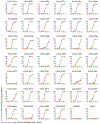
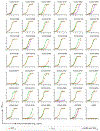
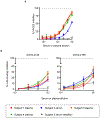


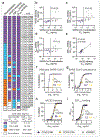
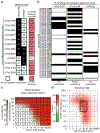



Update of
-
Potently neutralizing human antibodies that block SARS-CoV-2 receptor binding and protect animals.bioRxiv [Preprint]. 2020 May 22:2020.05.22.111005. doi: 10.1101/2020.05.22.111005. bioRxiv. 2020. Update in: Nature. 2020 Aug;584(7821):443-449. doi: 10.1038/s41586-020-2548-6. PMID: 32511409 Free PMC article. Updated. Preprint.
Similar articles
-
Isolation of potent SARS-CoV-2 neutralizing antibodies and protection from disease in a small animal model.Science. 2020 Aug 21;369(6506):956-963. doi: 10.1126/science.abc7520. Epub 2020 Jun 15. Science. 2020. PMID: 32540903 Free PMC article.
-
Structures of Human Antibodies Bound to SARS-CoV-2 Spike Reveal Common Epitopes and Recurrent Features of Antibodies.Cell. 2020 Aug 20;182(4):828-842.e16. doi: 10.1016/j.cell.2020.06.025. Epub 2020 Jun 24. Cell. 2020. PMID: 32645326 Free PMC article.
-
Potent neutralizing antibodies from COVID-19 patients define multiple targets of vulnerability.Science. 2020 Aug 7;369(6504):643-650. doi: 10.1126/science.abc5902. Epub 2020 Jun 15. Science. 2020. PMID: 32540902 Free PMC article.
-
Antibody tests for identification of current and past infection with SARS-CoV-2.Cochrane Database Syst Rev. 2022 Nov 17;11(11):CD013652. doi: 10.1002/14651858.CD013652.pub2. Cochrane Database Syst Rev. 2022. PMID: 36394900 Free PMC article. Review.
-
COVID-19 Vaccines: "Warp Speed" Needs Mind Melds, Not Warped Minds.J Virol. 2020 Aug 17;94(17):e01083-20. doi: 10.1128/JVI.01083-20. Print 2020 Aug 17. J Virol. 2020. PMID: 32591466 Free PMC article. Review.
Cited by
-
A Rapid and Efficient Screening System for Neutralizing Antibodies and Its Application for SARS-CoV-2.Front Immunol. 2021 Mar 22;12:653189. doi: 10.3389/fimmu.2021.653189. eCollection 2021. Front Immunol. 2021. PMID: 33828563 Free PMC article.
-
COVID-19 vaccine immunogenicity among chronic liver disease patients and liver transplant recipients: A meta-analysis.Clin Mol Hepatol. 2022 Oct;28(4):890-911. doi: 10.3350/cmh.2022.0087. Epub 2022 Jun 3. Clin Mol Hepatol. 2022. PMID: 36263669 Free PMC article.
-
Complete map of SARS-CoV-2 RBD mutations that escape the monoclonal antibody LY-CoV555 and its cocktail with LY-CoV016.bioRxiv [Preprint]. 2021 Feb 22:2021.02.17.431683. doi: 10.1101/2021.02.17.431683. bioRxiv. 2021. Update in: Cell Rep Med. 2021 Apr 20;2(4):100255. doi: 10.1016/j.xcrm.2021.100255. PMID: 33655250 Free PMC article. Updated. Preprint.
-
Antibody evasion by the P.1 strain of SARS-CoV-2.Cell. 2021 May 27;184(11):2939-2954.e9. doi: 10.1016/j.cell.2021.03.055. Epub 2021 Mar 30. Cell. 2021. PMID: 33852911 Free PMC article.
-
Application of a Receptor-Binding-Domain-Based Simple Immunoassay for Assessing Humoral Immunity against Emerging SARS-CoV-2 Virus Variants.Biomedicines. 2023 Dec 1;11(12):3193. doi: 10.3390/biomedicines11123193. Biomedicines. 2023. PMID: 38137414 Free PMC article.
References
Publication types
MeSH terms
Substances
Grants and funding
- 75N93019C00074/AI/NIAID NIH HHS/United States
- 75N93019C00062/AI/NIAID NIH HHS/United States
- WT_/Wellcome Trust/United Kingdom
- S10 RR028106/RR/NCRR NIH HHS/United States
- T32 AI138932/AI/NIAID NIH HHS/United States
- U01 AI150739/AI/NIAID NIH HHS/United States
- T32 AI007163/AI/NIAID NIH HHS/United States
- R35 HL145242/HL/NHLBI NIH HHS/United States
- UL1 TR002243/TR/NCATS NIH HHS/United States
- R01 AI130591/AI/NIAID NIH HHS/United States
- T32 AI007151/AI/NIAID NIH HHS/United States
- T32 AI095202/AI/NIAID NIH HHS/United States
- R01 AI157155/AI/NIAID NIH HHS/United States
- F32 AI138392/AI/NIAID NIH HHS/United States
- F31 AI145189/AI/NIAID NIH HHS/United States
- F30 AI152327/AI/NIAID NIH HHS/United States
LinkOut - more resources
Full Text Sources
Other Literature Sources
Molecular Biology Databases
Miscellaneous

